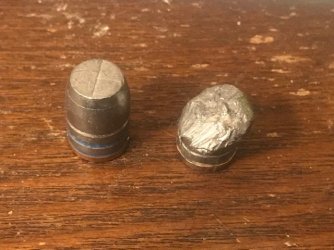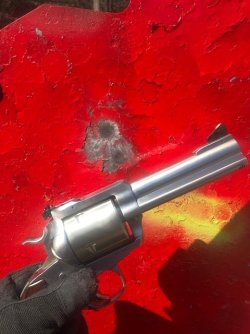I have been casting for 65 years and have found that cast bullets of brinnell from 12 to 15 are plenty hard enough as long as as-sized diameter fits the gun properly, and an adequate lubricant is used. I have used an equivalent to Saeco Green that I blend myself. I have used this lube for about 35 years and have had no leading issues with rifles, revolvers or semi-automatics.
Harder bullets are not needed than 12-15 brinnell for handguns or rifles, but up to ca. 22 brinnell (linotype) does no harm. Any more results in excessive cost due to the alloying metals cost and.or much more work than is necessary by additional steps like water-quenching!
I also have come to agree with Elmer Keith that gas checks are not necessary for either handguns or rifle cartridges as long as hardness, fit and lubrication are correct as explained above.
I have no respect for Keith, he was one of the greatest bull-crappers of all time. Gas checks are necessary for rifle bullets as it prevents the bullet base from being distorted by the hot burning gases. Experiments with both jacketed and lead bullets going back over 130 years prove that if the base is not "square" so to speak the accuracy will be dismal. My own testing verified this once again as lead rifle bullets with gas checks shot much better than those that did not have gas checks.
If you want to learn about accuracy read the book by Dr. Mann called "The Bullet's Flight From Powder to Target: Ballistics of Small Arms by F.W. Mann". Although it was written way back in 1900 it was the first scientific conducted tests on accuracy and what Dr. Mann found is still very relevant today in modern times. Mann accepted nothing but provable testing, unlike Keith who wrote about anything that happened to cross his mind on a given day with nothing to back up his claims most of the time. Not to mention the money making schemes Keith was involved with when he was a "front man" for two charlatan gunsmiths that were pandering their newest "latest and greatest" wildcat calibers that did nothing that was already being done with long established factory rifle calibers.
Keith books are highly entertaining to the point of being ridiculous and hilarious like the time he claimed the .270 his client was using was so anemic that he had to hold on to the back legs of a mountain sheep while his client had to beat the poor animal to death with the butt of his .270 rifle. O'Connor in his book "Confessions of a Gun Writer" tracked down the "client" who said Keith was not even with him that day because Keith had been hired on the hunt as the chief cook and bottle washer and was back in camp washing dishes at the time.
Keith's bull crapping story of making that 650 yard shot on a pronghorn with only a hot loaded .44 special resulted in a rare and very rare occurrence of fellow gun writers all calling him a liar because the trajectory alone would have demanded he aim well above the animal to the point where he could no longer see the animal he was shooting at and Keith even also claimed the animal was even running at the time.
And it is a myth that Keith invented the .44 magnum, rather he only recommended that a new and hotter .44 revolver cartridge be developed which was done not even by Smith & Wesson but actually by Remington Ammunition Ballistics experts.
Keith also claimed to have invented various new wildcat calibers which was again pure bull as again he was being a front man for two gunsmiths who were the actual inventors even though their so called inventions again did nothing new at all.
Keith also beat the "big bore" drums for years obviously unaware that he had already been proven wrong before he even became a gun writer as various Professional Old Time and very famous African Elephant Hunters proved the "big bore" myth just that a "myth" as quite a few of them used medium or even small calibers that killed elephants very dead i.e. the 6.5mm and 7x57, .303 British and 8x57, not the big bore blasters Keith claimed were necessary for even shooting enraged and dangerous barn mice.
O'connor liked to razz Keith in his Outdoor Life Articles by proving him wrong many times which resulted in a feud between both men and O'Connor did this on purpose to raise Magazine Subscriptions having fun all the while doing it. O'Connor was a former University Dean of Journalism while the uneducated hillbilly Keith had to have his articles re-written by the Magazine Editor so they would be coherent to their readers because Keith was mostly illiterate.
For a good laugh read Keith's hilarious books but for serious students of the gun O'Connor and Warren Page were the experts of their day.



